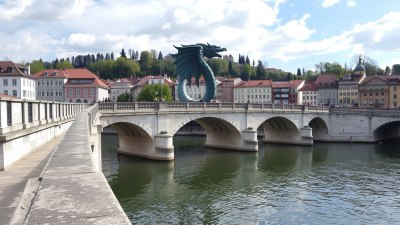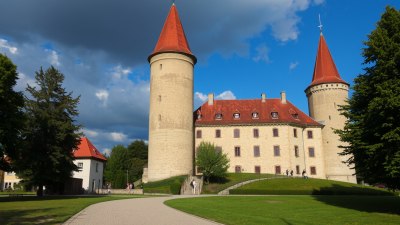Ljubljana's Dragon Bridge: Exploring Slovenia’s Capital
Discover the iconic Dragon Bridge in Ljubljana, a symbol of Slovenia's capital, with its rich history and architectural beauty.

Image created with Flux Schnell
Ljubljana, the charming capital of Slovenia, boasts a rich history, vibrant culture, and picturesque scenery. One of its most iconic landmarks is the Dragon Bridge (Zmajski Most), a beautiful piece of architecture that symbolizes the spirit of the city. In this article, we will explore everything you need to know about the Dragon Bridge, from its construction to its significance in Ljubljana's history.
Finished in 1900, the Dragon Bridge was built during the time when Ljubljana was a part of the Austro-Hungarian Empire. Designed by the architect Jurij Zaninović, the bridge was constructed to support the increasing traffic of the city. At the time, it was a modern engineering marvel, showcasing the techniques and styles of the era, along with its unique features that make it a notable point of interest in Ljubljana.
The most striking aspect of the Dragon Bridge is undoubtedly the four magnificent dragon statues that stand guard on the bridge's corners. These green-hued, scaly creatures are not only stunning works of art but also fundamental to the bridge's identity. According to local legend, the dragons symbolize the town's founding, as they were believed to have been inspired by the story of Jason and the Argonauts, who supposedly passed through the region during their quest for the Golden Fleece.
Beyond their historical significance, the dragons were a remarkable feat of artistic imagination and engineering. Each dragon was cast in copper by the sculptor Franz Zajec, who infused a sense of life and motion into the statues. The presence of the dragons gives the bridge an enchanting character, making it a popular attraction for tourists and locals alike.
The Architecture of the Dragon Bridge
The architectural style of the Dragon Bridge is a blend of Art Nouveau and the engineering technologies of the late 19th century. The bridge stretches 33 meters in length and 20 meters in width, making it wide enough to accommodate both pedestrian and vehicular traffic. Its iron trusses and arches are coated in striking turquoise paint that has been a defining feature since its completion, allowing it to stand out against the surrounding landscapes.
One of the engineering innovations of the Dragon Bridge is its use of reinforced concrete, which was a groundbreaking technology at the time. This ensured the bridge's durability and strength, allowing it to withstand the heavy loads of modern traffic for over a century. The combination of artistic elegance and structural integrity showcases the brilliance of early 20th-century engineering.
Visiting the Dragon Bridge
The bridge serves as a picturesque backdrop for photographs and is particularly stunning during sunset when the golden rays illuminate the dragon statues. Many visitors also enjoy the night view of the bridge, as it is beautifully lit, casting a magical glow over the river below.
Surrounding Attractions
While the Dragon Bridge is a focal point, it is far from the only attraction in Ljubljana. Nearby, visitors can find the famous Triple Bridge, another architectural masterpiece that connects the modern and historic parts of the city. The Central Market is also just a short walk away, where one can experience the local flavors and delicacies of Slovenian cuisine.
The Ljubljana Castle is another nearby landmark that offers a magnificent view of the city from its hilltop. It can be reached by foot or a funicular railway, making it an enjoyable excursion for visitors. The castle's history dates back to the 11th century and adds a layer of depth to your exploration of Ljubljana's past.
The Cultural Significance of the Dragon
The dragon is more than just a decorative element of the bridge; it holds cultural importance for the people of Ljubljana. Dragons appear in various legends and folklore throughout the region, often symbolizing strength and resilience. They have become an emblem of the city, and their images can be found in various forms throughout Ljubljana.
Every year, the city hosts events and festivals that celebrate its cultural heritage, and the dragon often plays a central role in these festivities. It's not uncommon to see dragon-themed merchandise and souvenirs in the shops, reminding visitors of the legendary creature and its ties to the city's identity.
Visiting the Dragon Bridge in Ljubljana is not just about admiring a beautiful structure; it is about engaging with the city's history and cultural significance. This iconic landmark encapsulates the spirit of Slovenia’s capital, serving as a reminder of its rich past while continuing to be a vital part of its present. Whether you're a history buff, architecture enthusiast, or simply a curious traveler, the Dragon Bridge and its enchanting dragons are sure to leave a lasting impression during your journey through Ljubljana.











